| |||||
| Centuries: | |||||
|---|---|---|---|---|---|
| Decades: | |||||
| See also: | List of years in Scotland Timeline of Scottish history 1706 in: England • Wales • Elsewhere | ||||
Events from the year 1706 in the Kingdom of Scotland .
| |||||
| Centuries: | |||||
|---|---|---|---|---|---|
| Decades: | |||||
| See also: | List of years in Scotland Timeline of Scottish history 1706 in: England • Wales • Elsewhere | ||||
Events from the year 1706 in the Kingdom of Scotland .
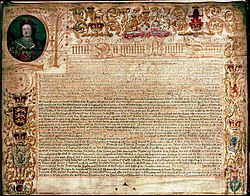
Date unknown
Date unknown
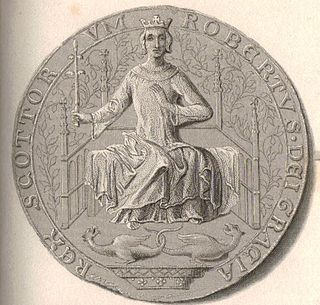
Robert II was King of Scots from 1371 to his death in 1390. The son of Walter Stewart, 6th High Steward of Scotland, and Marjorie, daughter of King Robert the Bruce, he was the first monarch of the House of Stewart. Upon the death of his uncle David II, Robert succeeded to the throne.

Sir Henry Raeburn was a Scottish portrait painter. He served as Portrait Painter to King George IV in Scotland.
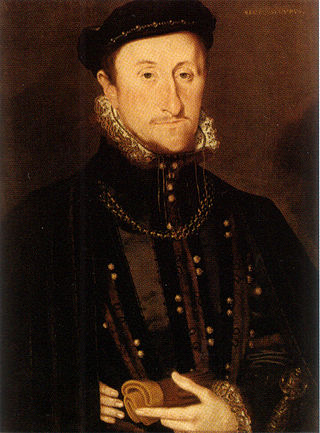
James Stewart, 1st Earl of Moray was a member of the House of Stewart as the illegitimate son of King James V of Scotland. At times a supporter of his half-sister Mary, Queen of Scots, he was the regent of Scotland for his half-nephew, the infant King James VI, from 1567 until his assassination in 1570. He was the first head of government to be assassinated with a firearm.
John Stewart, 4th Earl of Atholl, called the Fair, was a Scottish nobleman and courtier. He was favoured by Mary, Queen of Scots, but later turned against her.
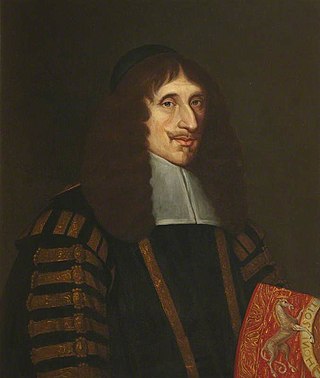
John Campbell, 1st Earl of Loudoun was a Scottish politician and Covenanter.

The office of Lord Clerk Register is the oldest surviving Great Officer of State in Scotland, with origins in the 13th century. It historically had important functions in relation to the maintenance and care of the public records of Scotland. Today these duties are administered by the Keeper of the National Records of Scotland and the Keeper of the Registers of Scotland.

James Hamilton, 1st Earl of Arran and 2nd Lord Hamilton was a Scottish nobleman, naval commander and first cousin of James IV of Scotland. He also served as the 9th Lord High Admiral of Scotland.
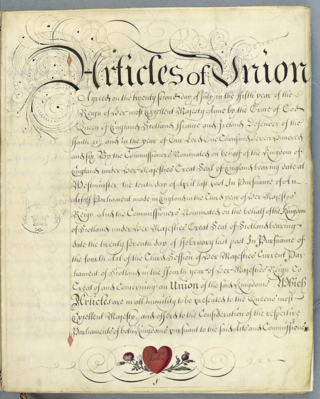
The Treaty of Union is the name usually now given to the treaty which led to the creation of the new state of Great Britain, providing that the Kingdom of England and the Kingdom of Scotland were to be "United into One Kingdom by the Name of Great Britain". At the time it was more often referred to as the Articles of Union.
Events from the year 1705 in the Kingdom of Scotland.
Events from the year 1700 in the Kingdom of Scotland.
Walter Campbell, 3rd of Shawfield and Islay and 9th of Skipness was a Scottish landowner, advocate and Rector of Glasgow University.
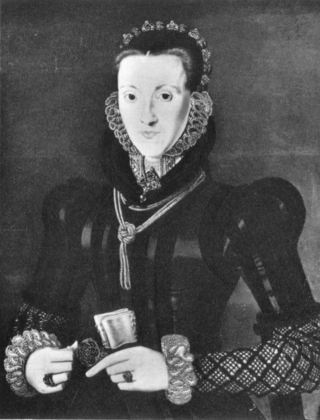
Agnes Keith, Countess of Moray was a Scottish noblewoman. She was the wife of James Stewart, 1st Earl of Moray, regent of Scotland and the illegitimate half-brother of Mary, Queen of Scots, making her a sister-in-law of the Scottish queen. As the wife of the regent, Agnes was the most powerful woman in Scotland from 1567 until her husband's assassination in 1570.
Alexander Gordon, 3rd Earl of Huntly was a Scottish nobleman. He was a member of Parliament, a member of the Privy Council, a regent and Lieutenant of the kingdom.
The Squadrone Volante or New Party was a political grouping in Scotland which emerged around 1700 as an offshoot of the opposition Country Party. Led by John Ker, 5th Earl of Roxburghe and John Hay, 2nd Marquess of Tweeddale, the party was influential in passing the Act of Union with England in 1707.
The Hon. John Campbell, of Mamore, was a Scottish Whig politician who sat in the Parliament of Scotland from 1700 to 1707 and in the British House of Commons between 1708 and 1727.
John Gordon, 11th Earl of Sutherland (1525–1567) was a Scottish magnate. John Gordon supported the chief of his family, his cousin the Earl of Huntly against the Earl of Moray. After Huntly's defeat at Corrichie, he went into exile, and shortly after his return to Scotland he was murdered by a kinswoman.
Events from the year 1707 in the Kingdom of Scotland, then Scotland.
Events from the year 1715 in Scotland.
Events from the year 1717 in Scotland.
James Stewart, 1st Lord Doune (1529-1590) was a Scottish landowner.